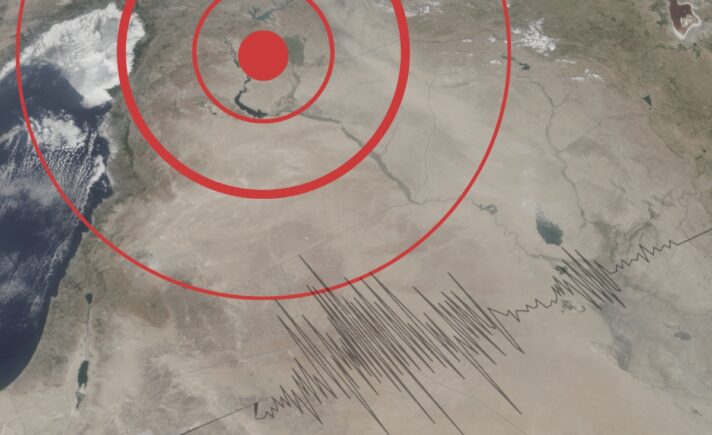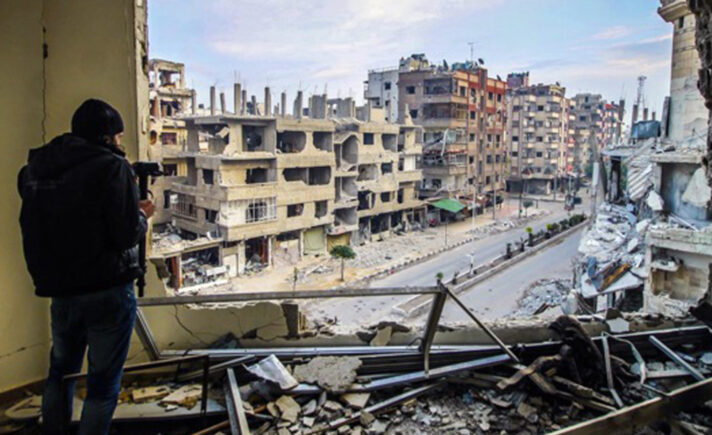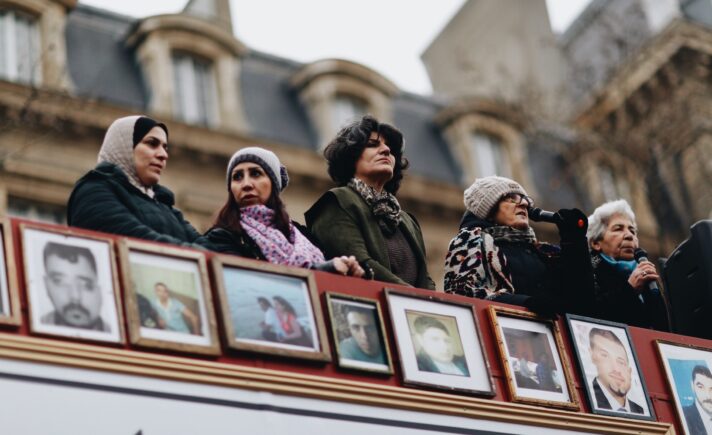“In a world that is really upside down, the true is a moment of the false.” — Guy Debord
The international community may still see Bashar al-Assad as a demon, but he is back on the international stage, and nations such as France accept to deal with him when it comes to sending humanitarian aid to Syria. When “the Doctor” is ready to give an interview, moreover, all the world’s media line up to catch his words.
“How can we leave this generalized state of abjection? We have personally tried to denounce, to analyze, to propose. But it’s no use,” deplores the Syrian militant filmmakers’ collective Abounaddara, dedicating their work to transcending all Syria-related narratives in favor of a series of portraits of everymen and women among Syrian civil society.
An even more ominous warning is their short clip entitled “All the Syria’s Futures”: the video of a triumphant Assad being ceremoniously greeted by his army at the presidential palace to the sound of Ode to Joy is interrupted by a “technical failure.” The viewer is then told to “keep enjoying the spectacle.”
Syria as spectacle
To figure out what the “spectacle” is precisely, at least in relation to today’s Syria, we have to start with what it isn’t.
When the Italian Marxist author Domenico Losurdo passed away, he left us with, among other writings, some extroardinarily conspiracist lucubrations on the nature of Western discourse regarding the dictators it has seemingly attempted to unseat, including Bashar al-Assad. Resorting to a simplistic understanding of the French Marxist Guy Debord’s The Society of the Spectacle, whose conceptual framework frequently serves as the go-to tool for lazy media critics lacking imagination, he explained that the Western press—the “industry of lies” produced by the “society of spectacle”—unfairly demonized anti-imperialist strongmen while legitimating Western wars of aggression directed against their regimes. “Spectacle” then would be a lie produced by the mass media to justify its own aggressive foreign policy.
Playing geopolitician as well as media critique, much like Noam Chomsky, Losurdo’s blogposts cite only Western media to turn the Lügenpresse against itself. This methodological and epistemological Western-centrism postulates that all one is required to know about the Syrian people and their rulers, for instance, comes from inversing the moral judgment which our own rulers carry upon them. And then, almost by a show of magic, the Syrian opposition turns from “moderate” to “radical” or even “jihadi,” and a “criminal” regime becomes “legitimate.” Rather than dissecting the simplicity of a binary discourse or facing the very vacuity of terms such as “legitimate,” “moderate,” or “radical” in a war like Syria’s, the “academic” chose to simply adopt it as their own while switching the signs around its poles.
Such a reference to Debord’s work is twice as disappointing, given that the concepts derived from it may very well provide the last resort against widespread narratives regarding war in Syria that de-center the discussion away from civilians’ lived experience and agency.
Debord himself warned against turning “the critical concept” of the “spectacle” into “one more hollow formula of sociologico-political rhetoric used to explain and denounce everything in the abstract, thus serving to reinforce the spectacular system.” He never implied that the spectacle was a simple “lie,” rather that it had transcended authenticity, by shaping its own reality: “The spectacle cannot be understood as a mere visual excess produced by mass-media technologies. It is a worldview that has actually been materialized, a view of a world that has become objective.”
In a certain sense, the conspiracists will thus have always been correct in retrospect. In Syria, the spectacular fight between civilization (represented, of course, by President Assad’s vast security apparatus and kleptocratic economy) and the apocalypse (anything that escaped their control), initially conceived of in propaganda speeches back in 2011, occurred materially precisely within those social spaces where alternatives to Assad’s civilization seemed to emerge. Faced with a scorched-earth campaign of industrial proportions, summed up by the loyalists’ slogan “Assad or we burn the country,” fragmenting and destroying millions of lived experiences, Syria was slowly reoccupied by a fascistic state under the control of a predatory capitalist class, continually represented as the unique solution for the avoidance of complete annihilation.
Apathy in the face of the apocalypse
Apocalyptic representations of a devastated society only reinforce Assad’s genocidal project—“genocidal” precisely in the way just summarized by his Air Force Intelligence chief, Jamil al-Hassan, according to whom a “Syria with 10 million trustworthy people obedient to the leadership is better than a Syria with 30 million vandals.”
Previously, the controversial Syria watcher Fabrice Balanche had written in Syria Deeply: “In the absence of sensible economic improvement, the majority of Syrian refugees are likely to remain in host countries, where new arrivals will join them. This prospect does not bother Assad, who may have come to realise that Syria was overpopulated in 2011, in terms of its economic capabilities, and that this was a major cause of the revolt.”
By now, Syria seems to have mostly been rid of those unwanted elements that had caused or were likely to contribute to continuing unrest—sometimes by their mere presence. The representation of the entire opposition as “vandals,” wanting senseless destruction, or “jihadis,” a term deriding those supposedly wanting to bring about the end of civilization itself, ensured that Assad could be considered legitimate and acceptable, if not as a democratic president, then at least as a temporary defender of Syria against a ruthless war waged for the sole purpose of destruction.
By drawing upon apocalyptic imagery, ISIS ensured that Assad could be absolved of his early crimes in a life-or-death struggle between society (his society) and one of the most atrocious faces of nihilism the world has ever seen. Rather than an unfortunate outcome, the scenario was an inevitable result of the totalizing, spectacular binary at play in Syria: “Assad or no one.” As Westerners started taking serious interest in the conflict in 2013, amidst its internationalization, it was crucial that the dichotomy was perceived correctly: jihadist nihilism had to ontologically precede Assadist nihilism in order for the latter to be absolved of all crimes.
Assad’s bombardment may be seen as a lesser evil if and only if it is necessary to fight the likes of ISIS. But now apologists could go even further and claim jihadism was also the original sin of the Syrian uprising (forcibly imported from the outside then, given that the pure, peaceful Syria belonged to the Assad family in its entirety and couldn’t conceive of such a monster); the one which Assad noticed in its inception and started combatting as far back as 2011.
What was omitted were the linkages between jihadist and Assadist nihilism, exposed by activists and intellectuals—such as Yassin al-Haj Saleh—and which Syrian civil society never forgot. Thus, according to Dr. Lina Khatib, the recent deadly ISIS-led attack on Suwayda represented, more than anything, a “calculated step of ignoring pockets of ISIS influence as part of a plan to punish the population for defying the regime.” ISIS fighters had come from the “eastern desert on the border of Iraq and Syria,” where they had been reconducted by Assad’s forces themselves at the end of their campaign in the Yarmouk basin. “Although ISIS attacked some regime checkpoints in the process, pro-regime forces largely left ISIS alone as it proceeded in its attack.”
Throughout the war, ISIS has alternated between doing Assad’s own bidding, burying the revolution better than he could have done himself, and being his staunchest nemesis: in all cases, the value of the terrorist group was always relative to its place within the Assadist spectacle.
Not so much a rational or even an irrational actor, ISIS should perhaps be seen as a commodity whose circulation was paid for in Assad’s own currency. And as we know from Debord, “each individual commodity fights for itself. It avoids acknowledging the others and strives to impose itself everywhere as if it were the only one in existence.”
The brilliance of Assadist representation is that even when some become fully cognizant of the nihilistic aspect to Assad’s own project, the apocalyptic dimension leaves them in apathy, as nothing seems to be possible, nothing other than watching the wreckage on their mobile phone and eventually helping those who made it out.
Syrians as victims, or killers
Beyond videos of bombardment compressed into social media formats and allowing for only a pre-selected set of reactions, few actually wonder about the intricacies of Syrian lived experiences.
For those of us whose parents lived through the Cold War, and who have grown up on Hollywood blockbusters, it might be easier to imagine a nuclear apocalypse as a result of a fantasized “World War Three” against Russia than to empathize with those surviving an actual holocaust. Thus, we absorb fascinatingly wild videos of InfoWars’ Alex Jones losing his mind over the “false flag attacks” meant to bring about American war “against Syria” that are somehow more viscerally relatable than Syrian society’s attempt to hold local council meetings to provide for communities’ needs under siege.
What is distant has to be denied agency and processed through dichotomies, which is glaringly obvious in the confused discourse around the White Helmets rescuers. Still rescuing civilians from the rubble to this day, they carry their own stories of mistakes, and some might even—in a moment of rage and desperation—pick up arms against those destroying their homes. The temporality of their lives is fragmented, much like Syria itself—and wars inevitably mess up people’s lives. But the fragments are then spectacularly reunited to form an artificial whole; either a narrative of conspiracy, Western-sponsored jihadism, or absolute heroism, without space for the contradictory experience of individuality.
“The images detached from every aspect of life merge into a common stream in which the unity of that life can no longer be recovered,” claims Debord. According to him, spectacle is made up of “fragmented views of reality [which] regroup themselves into a new unity as a separate pseudoworld that can only be looked at.”
In that regard, it’s all the less surprising that as all eyes were fixed on the international operation attempting to evacuate the remaining aid workers from southwestern Syria reconquered by Assad, there has been comparatively little outrage over the fact that only a minority ultimately made it out of the country. The image of the West “rescuing rescuers” from the wreck of humanity that is Syria was all too powerful for anyone to notice the missing.
The children pulled out of the rubble, such as Omran Daqneesh, covered in blood and in a state of shock, unable to cry, are also denied individuality as they “go viral” and turn into universal icons of suffering children. Their images are hijacked so that their eyes display all the injustices of this world, and rather than sharing their pain, all of ours is projected onto them.
Reality ceases to be that which is lived by those suffering on the ground: originating in propagandistic representations, it is instead imposed onto Syrians from the top down, much like the rain of missiles inflicted upon the liberated cities by Putin’s and Assad’s air forces, which leave no space to breathe in between the Assad-backed genocidal militias and the vehemence of jihadist fighters, converging to make apocalyptic dichotomies reality.
A difficult yet humane response to the ongoing tragedy in Syria would be to re-center the discourse around communities and civilians themselves, whose lives have an intrinsic, rather than a comparative value within a narrative. Ceasing to impose a particular, often spectacular reading of the conflict, whether through pathos or logos, might prompt us to meditate on the Qu’ranic verse that has motivated Syrian civil defense workers more than anything else, the one that has its origins in the Jewish Talmud: “Whoever saves one life, it is as though he had saved all humanity.”
Instrumentalized narratives
As the spectacle of destroyed Syria is presented to the rest of the world to be consumed at ease, between debates on what we ought to do in the Middle East, its logic permeates the destruction of Syrian lives. The spectacular narratives mobilized by Assad to legitimate his own regime are key not only to dupe the global audience, but also to rehabilitate global fascism.
As the Lebanese-American Syria solidarity activist Malek Rasamny put it to Al-Jumhuriya, “the way Assad positions himself is by combining the minoritarian scare tactics that we would associate with the Lebanese establishment and the Christians of Lebanon, but also as a friend of Palestine; against Islamism and against the West. The position his regime occupies discursively is fantastic. All the narratives work to his favor. When you’re going off of narratives instead of looking at the reality on the ground, that’s what happens.”
A researcher and filmmaker, Rasamny has spent a significant amount of time exploring the question of how identities and experiences of the oppressed and the marginalized transcend narratives, albeit in very different contexts. Along with Matt Peterson, he co-directed the multimedia documentary “The Native and the Refugee,” attempting to connect lived experiences of Palestinians in various refugee camps with those of the residents of several reservations for Native Americans. Yet, the discussion rapidly shifts to Syria.
“The people aren’t accustomed to looking at details on the ground,” he says. “We are still used to the idea of ‘one analysis’ versus ‘another analysis.’ Not to the fact that I can pick up the phone and call a guy in Hama. And on a deep level, people don’t care. There is no social incentive to support the Syrian revolution. If you make pro-Assad arguments, you say just enough to sound smart. The truth doesn’t carry too much social currency, unfortunately.”
Representing the limits of the dichotomy
Burning Country: Syrians in Revolution and War, which Leila Al-Shami co-wrote with Robin Yassin-Kassab, stands out as one of the very rare attempts to paint a people- and witness-centered account of the Syrian uprising. “The Western media or the Western commentators in general already have their own grand narratives, which have very much to do with the geopolitical situation, or with the humanitarian crisis, or with the war on terror and the threat of Islamic extremism. They seem to dominate both the media and the publications around Syria, which was upsetting for us,” Al-Shami told Al-Jumhuriya.
She maintains that, by being locally engrained, the Syrian revolt was one of a kind and uncategorizable, despite having been influenced by the other Arab Springs and protest movements in the rest of the world. “Syrians as everyone else have been affected by globalization, by economic neoliberalism, by climatic issues which also played into the causes for the uprising, but there are also very specific local conditions which are the reason people originally go into streets. For instance, in certain towns, people began by talking about local-level corruption before they developed nation-wide demands. And yes, everything that happens has ramifications in other parts of the world, but people’s lived experiences are still very local in many ways.”
If on a local level, the focus on regional corruption and abuse of power was naturally making the revolt immune to instrumentalization, when insurgent Syrians joined forces nationally, they were inevitably led to a direct confrontation with the Assadist monopoly on representation of Syria.
Contesting dictatorship and kleptocracy, Syrians fought both Assad and his cousin “Rami Makhlouf, the owner of Syriatel, a mobile network provider and numerous other modern projects” who represented “the bond between obscene wealth and kinship to the ruler,” narrates Yassin al-Haj Saleh. So “the protestors represented themselves: they used Makhlouf’s mobile phone cameras to share photographs and videos on social media networks, and send them to satellite television channels; they bore banners with their demands and chanted in peaceful demonstrations that lasted for 15 months (from March 2011 until July 2012); they produced articles, posters, graffiti, films, songs, paintings and cartoons.” In that, “the cultural field of representation is inseparable from the fields of economic and political representation, and one can’t be studied in isolation from the others.”
Little did they know that despite everything, the voices that were breaking into the mainstream were only heard at occasional events organized by the Syrian diaspora. The representation of Syria is monopolized by Assad—but when it isn’t, it is frequently at the expense of Syrians themselves.
That is precisely what filmmaker Sharif Kiwan, speaking for the Abounaddara collective, warns against when he mentions citizen reporters turned into “subcontractors” for television companies avid for “militant” images. “Why continue to invest in these problematic images when al-Assad’s stories have been vindicated by the spread of violence and the emergence of jihadists?” he asks. “The answer reveals itself to be as simple as it is despicable: ‘war from the inside’ offers television an opportunity to indulge its viewers’ voyeuristic urges without adhering to journalistic, legal, or ethical guidelines as they relate to a person’s right to his or her own image.”
Stripped of their last dignity, Syrians under siege by fascistic forces see their experience fragmented, annihilated only to be later viewed, instrumentalized and analyzed by the rest of the world, unable—or maybe unwilling—to prevent the massacres. And though there is still plenty of work to be done following and denouncing the human rights abuses that will forcibly ensue following Assad’s triumph, as well as preventing the forced return of Syrian refugees who still fear persecution, unlearning the toxic and self-destructive pattern of consuming representations of genocide might very well be our biggest emergency. If that won’t help us face the return of fascism on the global stage head on, then little else will.








